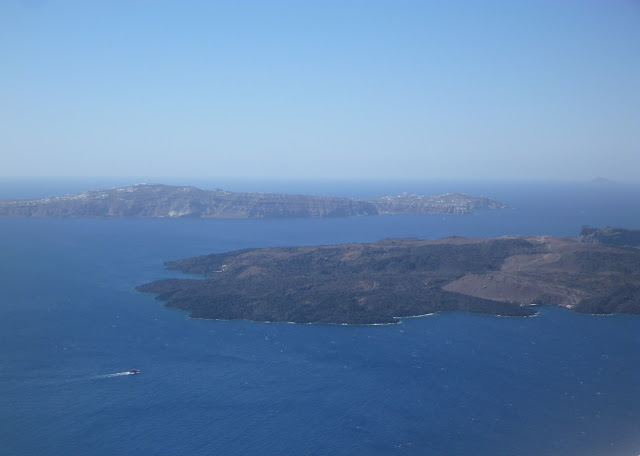
What remained after this blasting to smithereens are the present day islands of Santorini, Therasia and Aspronisi.
Nasa aerial photograph of Santorini
google image of Santorini
The volcano did not become extinct. From time to time it awoke bringing lava to the surface from the bowels of the earth. So, in time, the two islets in the centre of the caldera were created:
these islets are Palea Kameni (Old Burnt One) and Nea Kameni (New Burnt One), a later creation following successive eruptions of the volcano. On Nea Kameni is the crater from which, even today, gases and steam at a temperature of 80oC are emitted.
The consequences of the eruption were terrific, not only for Thera but also for the whole of the Aegean and for Crete, destroying the Minoan civilisation of the island.
The destruction of Thera is identified with the sinking of mythical Atlantis. We know of the legend of Atlantis from Plato. According to this story Atlantis was an extensive insular continent whose inhabitants had developed an exceptionally high standard of civilisation.
Since the days of Plato to the present day many attempts have been made to interpret the myth of Atlantis and thousands of studies and articles have been written on the subject. The date of the disaster is accepted by all as having occured around 1500 BC which is when the prehistoric eruption of the volcano occured.
It is this dating of the eruption that has led many scholars to believe that the lost Atlantis is Santorini itself and this is helped by the high standard of civilisation which is revealed by the excavations at Akrotiri. However, neither the size of the island, nor the phases of its cultural development are characteristic of omnipotent Atlantis. The sole great insular civilisation which developed in the Mediterranean in prehistoric times was the Minoan civilisation of Crete.
Crete was never submerged even though the eruption of the Thera volcano caused considerable destruction despite the fact that the distance between the two islands is 142 kilometres. The interpretation given by Prof Marinatos seems the most feasible, namely that mistakingly, the destruction of a civilisation (the Minoan) was attributed to the sinking of an island where this civilisation flourished (Crete), while in reality it was Thera which sank, and not completely.
Today, the surface layer of the soil in Santorini comprises enormous quantities of pozzuolana and pumice.
* * *
We did not go swimming this time as there was so much to do, but five years ago when I was last there, we went swimming to the 'red beach'. We had to climb up and down the side of a hill after getting off the bus and what we were scrabbling, slipping and falling on was loose fine pumice and tons of ash. When we got to the beach, it was red indeed, made up of fine pebbles of red pumice. The rest of Santorini's beaches, with the exception of the 'white beach' are made up of black sand - all a result of the volcanic eruptions.
Source: Santorini, Christos Doumas













No comments:
Post a Comment